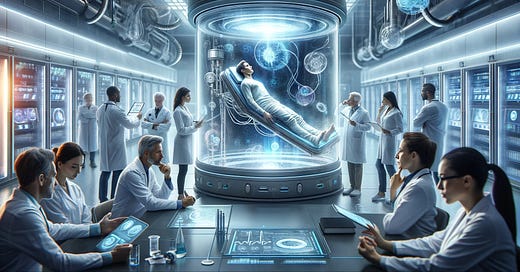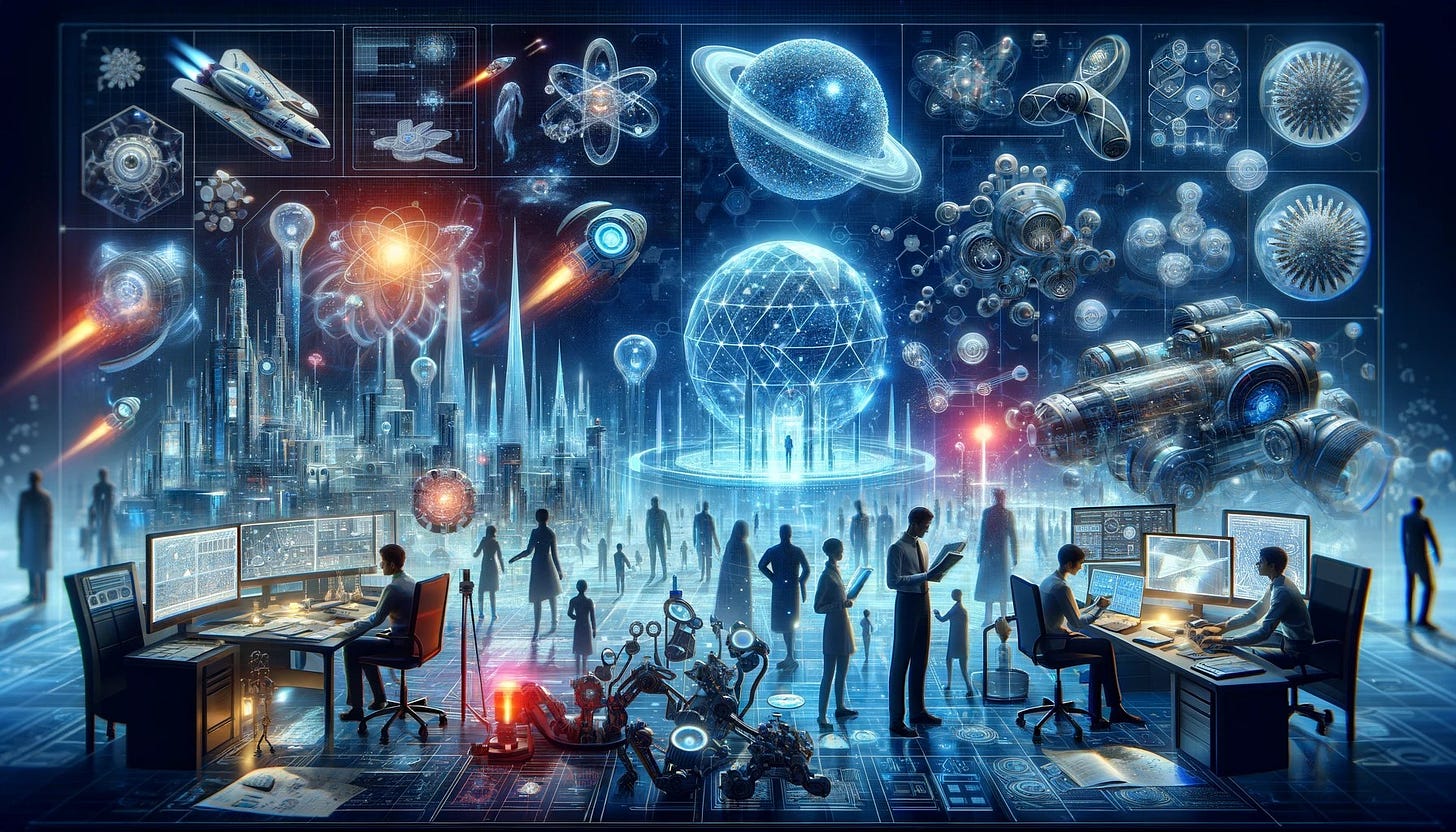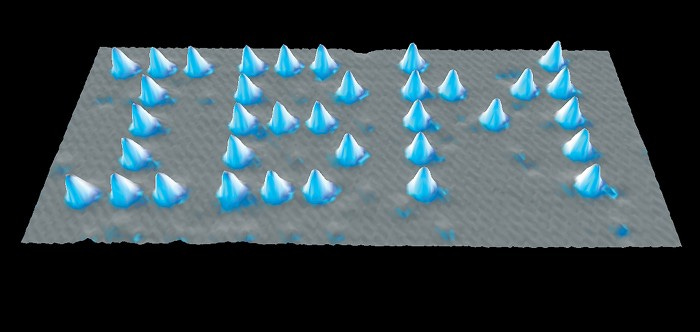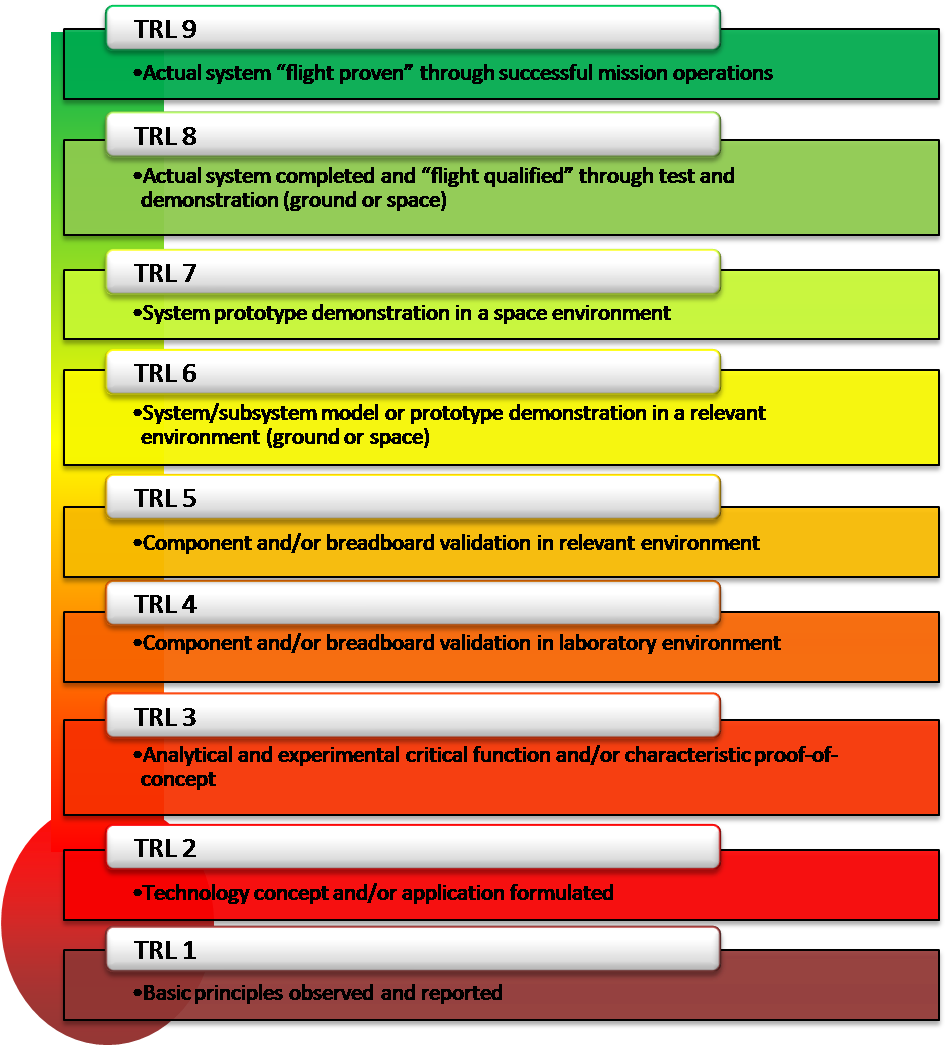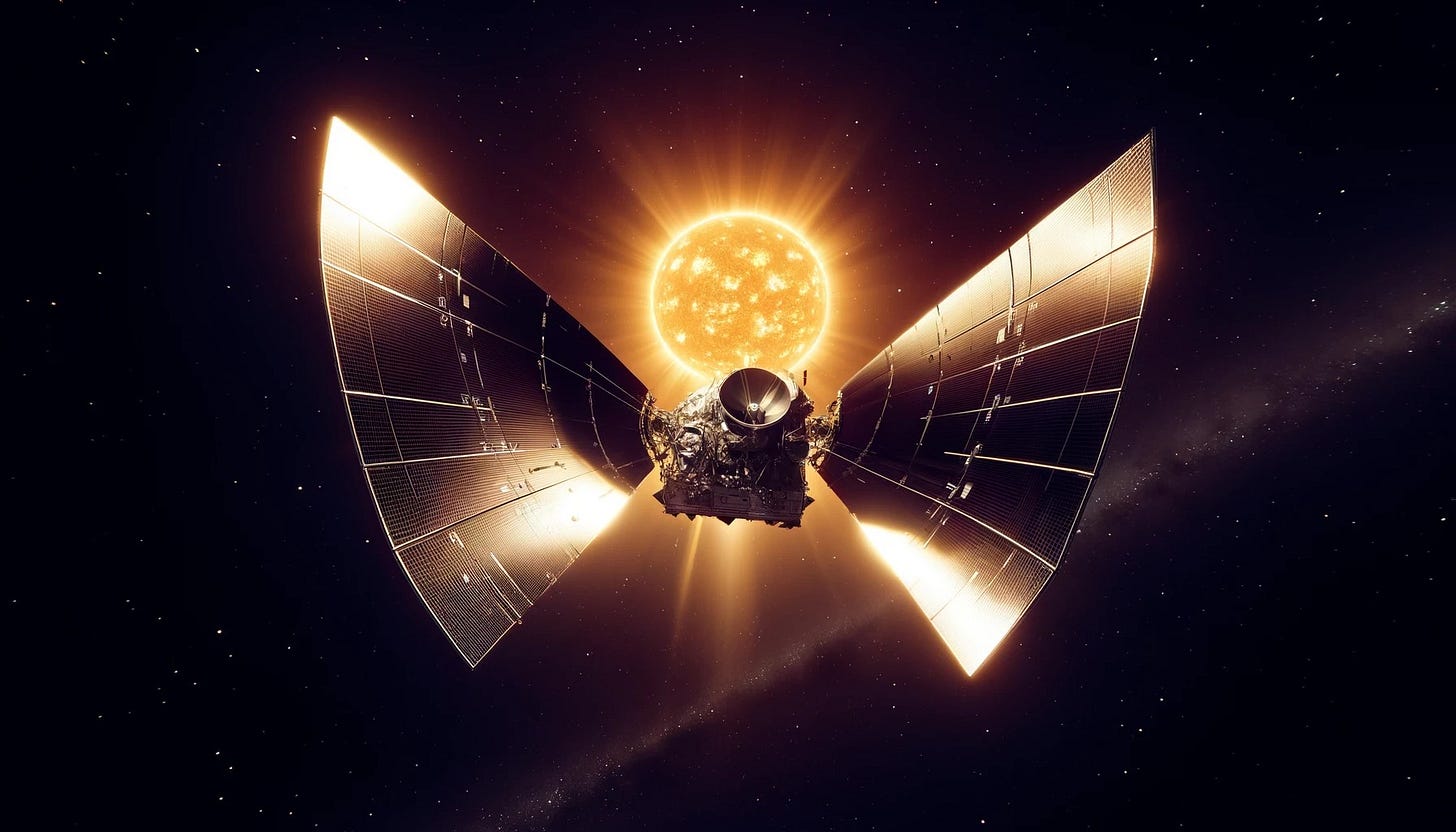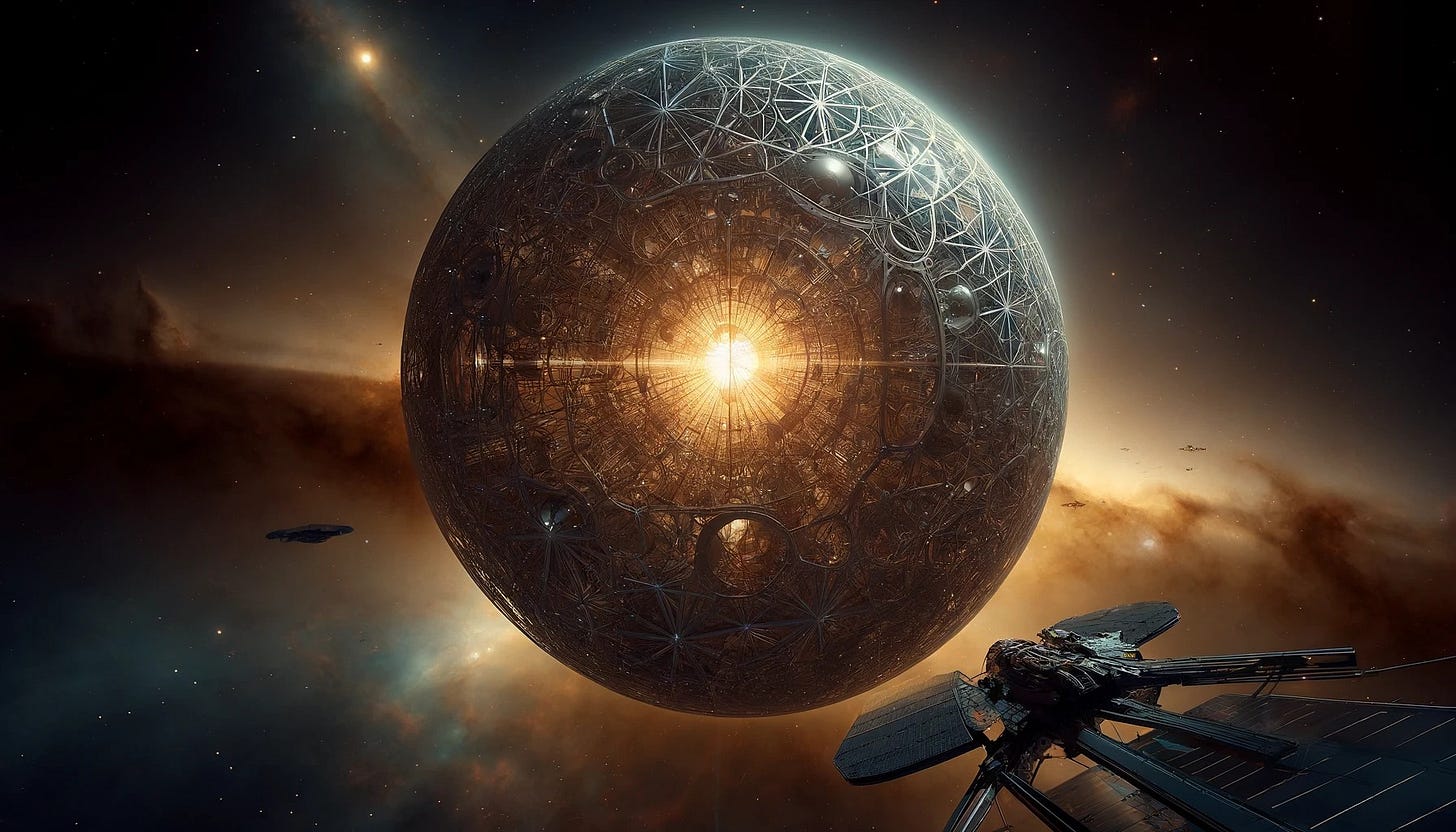The human mind is often so awkward and ill regulated in the career of invention, that it is at first diffident, and then despises itself. For it appears at first incredible that any such discovery should be made, and when it has been made, it appears incredible that it should so long have escaped men’s research. All which affords good reason for the hope that a vast mass of inventions yet remains, which may be deduced not only from the investigation of new modes of operation, but also from transferring, comparing, and applying these already known, by the method of what we have termed literate experience. -- Novum Organum, (1620) Book 1, 110.
“You can never plan the future by the past.” Edmund Burke, Author, philosopher
The future is not created by critical thinking alone. Nor is it created by unconstrained imagination or fantasy. A future of better conditions and greater capabilities comes from bold imagination disciplined by reason and science. One way to go wrong in thinking about the future is to lapse into fantasy. This is the realm of much popular science fiction. A more accurate name would be science fantasy or technological fantasy. Here we find the Star Trek transporters, the superheroes, and all of the Star Wars universe. Fantasy can be elaborate and fun but is not a guide to the possible.
On the other hand, some self-styled skeptics are infected with the opposite error – that of dogmatic rationalism, a form of scientism. “Scientism” is used frequently without definition. I mean the inappropriate application of scientific principles. This can take the form of uncritically applying the methods of one science to another, such as trying to explain behavior with the methods of physics. This can lead to disastrous consequences as we have seen with “scientific socialism.” Or it can mean inappropriately demanding proof when someone is exploring possibilities. It can result in an unhealthy condition that we can call a hardening of the orthodoxies in which the flow of ideas is so constricted that it leads to cognitive arrest.
The massive challenge of repairing biostasis patients
One day in the future we will likely have the ability to repair damage from the aging process and from the process of cryopreservation or chemical fixation and then revive a patient. For many people this proposition seems impossible and unimaginable. The more you know about the magnitude of the task the more implausible it may seem.
There are something like 32 trillion cells in the human body. Repair and revival means repairing membranes and organelles, removing toxic chemical compounds, reversing cross-linking, dealing with energy failure, ionic imbalance, excitotoxicity, nitrosative stress, inflammation, protein, RNA, and DNA stability, apoptosis, necrosis, and structural degradation, white matter damage, and histological ultrastructural change.
There is damage at every stage of the process: pre-mortem pathologies, post-mortem ischemia, cryoprotectant perfusion, freezing or cold vitrification, long-term cryogenic storage, rewarming/reperfusion. [You can find far more details in Robert Freitas’ book, Cryostasis Revival. For instance see p.399ff for analysis of the computational requirements.]
You probably find it hard or impossible to imagine how these challenges could be overcome. Does that mean the task is impossible or even improbable?
Biostasis – near and far
The essential proposition of cryonics – or, more broadly, biostasis – can be broken down into two related propositions. The first chunk of research and practice includes everything that goes into getting a patient preserved under the best conditions possible. That involves using the advances of emergency and resuscitation medicine, cryobiology research, protocols, and logistics. The second chunk concerns what will have to happen sometime in the future. That includes repairing damaged tissue, rewarming, and reviving the patient.
The first chunk makes use of existing technologies and methods. Emergency medical procedures and devices are used to restart circulation. Based on research results, drugs are selected to mitigate coagulation, acidosis, and other sources of damage in ischemic patients. Vitrification solutions used to prevent ice formation in cryonics patients are similar as used to vitrify tissues, eggs, sperm, and embryos. Standard CT scanning and electron microscopy is used to determine the degree of success in suppressing ice formation. The use may be non-standard but all the components of this part of the preservation process are standard and proven.
It makes no sense to demand that we prove that we will be able to repair and revive patients.
The second chunk of research and technology is more speculative or conjectural. New technologies will have to be invented if we are to repair preserved patients and restore them to life. It makes no sense to demand that we prove that we will be able to repair and revive patients. The only way to prove it in a strict sense is by doing it. Waiting until we have that proof will mean the permanent death of many people. When pharmaceutical companies investigate a new drug, they cannot prove that it will have the desired effect. They can narrow the field to promising candidates but must then test them. If they had to prove that a drug works before investigating it, they would never get started.
An excellent example of exploratory engineering for this second aspect of biostasis can be found in Robert Freitas’ book, Cryostasis Revival.
Demanding proof at an inappropriate stage of development often comes with an implicit or explicit assumption that if the critic cannot imagine how something could be accomplished then it cannot be accomplished. This assumption comes in strong and weak flavors.
Strong: I cannot imagine how it could be done, so it is impossible.
Weak: I cannot imagine how it could be done, so it will not happen.
The strong form of the claim is – once you focus on it – obviously and ludicrously false. Many of us have severely limited imaginations and a narrow base of knowledge with which to envision new possibilities. Even the most informed and imaginative are limited. Hardly any of the future is evident to us. When a few physicists in Switzerland created the protocol that created the world wide web, no one could foresee the myriad ways in which it would develop. When technologies collide, unexpected new technologies and products emerge. James Burke’s excellent 1978 show, Connections, masterfully illustrated this through the history of technology.
Both forms of the argument [from inability to imagine] imply a stunning level of arrogance. A person claims to be able to foresee all possible ways of achieving a goal and to know that none of them can work!
The weak form is almost as ridiculous for the same reasons. Both forms of the argument imply a stunning level of arrogance. A person claims to be able to foresee all possible ways of achieving a goal and to know that none of them can work!
Remember, these claims that “it cannot/will never happen” are not based on a physical proof. They come from head-scratching bafflement, not from demonstrating that a proposal necessarily violates the laws of physics. It is this arrogant ignorance that fuels the many quotes about impossibility that you have probably encountered. See my companion blog essay for many examples.
Today’s microchips are obviously impossible!
We quickly become so used to new technologies that we rarely stop to consider how implausible they would have seemed a few decades earlier. We walk around blithely with our portable supercomputers, hang high resolution screens on the wall, choose from an endless supply of information and entertainment at close to zero cost, and get our organs scanned by invisible waves.
Shift your perspective back to the first half of the 20th century. Imagine someone describing today’s microchips and the sophistication of their fabrication plants. If we could send back a detailed description, it would be considered science fiction. Probably even Jack Kilby, who invented the first microchip in 1958, the integrated circuit, would struggle to comprehend how these chips are possible.
Since the 1950s the cost of a transistor has fallen by about a factor of 300 million.
The cost of a semiconductor fab has increased from about $31 million in 2024 dollars to 10-$20 billion or more today. That’s around 300 to 600 times as expensive.
A current microchip has features around 50 nanometers (billionths of a meter) wide. Layers are only a few atoms thick.
Layers can be added to the wafer surfaces of a microchip that are no more than a nanometer thick. That’s 1/100,oooth the thickness of a human hair.
Chip manufacturing requires processes that are hundreds of thousands of times more accurate than conventional manufacturing.
What we can build today would seem inconceivable not so long ago. And yet we did it by gradually building innovation on top of innovation, driven by market incentives.
From advanced design to exploratory engineering
Much engineering uses established physical principles and existing materials and manufactured components to build structures. This applies from the macroscale of bridges, skyscrapers, and particle colliders to the micro- or nanoscale of chemistry, protein design, and genetic modification.
For products that do not yet exist, engineering has to be more speculative and exploratory. These may be relatively near term as tackled by programs such as the Apple Industrial Design group or the Lockheed Skunk Works. Other groups such as the Advanced Research Project Agency (ARPA) and the NASA Innovative Advanced Concepts (NIAC) Program generate and examine speculative designs that may take decades to realize in practice. The vast majority of people, even among engineers, may be unable to conceive how these could be achieved and yet no one accuses them of engaging in pseudoscience. Their speculation is bounded by physical laws.
NASA Institute for Advanced Concepts (NIAC) is a NASA program for “creating breakthroughs, radically better or entirely new aerospace concepts.” Studies selected for funding in 2024 include:
A Revolutionary Approach to Interplanetary Space Travel: Studying Torpor in Animals for Space-health in Humans (STASH)
Add-on to Large-scale Water Mining Operations on Mars to Screen for Introduced and Alien Life
Swarming Proxima Centauri: Coherent Picospacecraft Swarms Over Interstellar Distances
Electro-luminescently Cooled Zero-boil-off Propellant Depots Enabling Crewed Exploration of Mars
Some of the studies funded by the original NIAC 1998–2007:
Bio-Nano-Machines for Space Applications
Lunar space elevator – Jerome Pearson – final report.pdf
Mini-magnetospheric plasma propulsion
Momentum exchange tether
Space elevator
System Feasibility Demonstrations of Caves and Subsurface Constructs for Mars Habitation and Scientific Exploration (Caves of Mars Project)
Exploratory engineering (ExEng) pushes out the boundaries of exploration further by studying or developing the design of products and systems that cannot be built with existing tools and technologies. The line between ExEng and advanced design is not a sharp one. While the former involves things that we cannot currently build, the latter may require tools and technologies that we are currently unsure how to build. They differ in terms of the timeline of development and how close a proposal is to the physical limits of the possible.
Classic early examples can be found in Da Vinci’s designs for flying machines and other inventions. Many of them were workable but could not be made with the tools and materials of the time.
A more recent and vivid example is Konstantin Tsiolkovsky’s musings on rocket propulsion, use of liquid fuels, multi-stage rockets, space habitats and closed ecosystems, space suits and life support systems. In his day, most people would regard those as impossible and a waste of time to even think about. Today we have built all of them. Tsiolkovsky and then the British Interplanetary Society before World War 2 analyzed what it would it take to build a rocket to get to the moon. After the war, they updated their thinking to reflect experience with V2 liquid fuel rockets.
Those of us arguing that it should eventually be feasible to build cellular repair devices capable of reversing damage and restoring function to cryopreserved systems are in position similar to a person a hundred or more years ago arguing for the eventual feasibility of space travel. The immense challenges of inventing the necessary propulsion systems, life support systems, computers, and habitats would have seemed an insurmountable challenge.
There’s plenty of room for exploratory engineering
Some “hard” science fiction writers have followed up on the approach of Da Vinci and Tsiolkovsky by thinking realistically through how to build futuristic structures and devices, at least in outline. One of Feynman’s groundbreaking ideas was anticipated by Robert A. Heinlein – dozens of whose books I devoured in my mid-teens – in his 1942 story “Waldo.” Heinlein envisaged using successively smaller sets of interconnected manipulators down to the microscale.
Today, the best example of exploratory engineering is molecular nanotechnology as envisioned by Eric Drexler and glimpsed earlier by Richard Feynman. One branch – medical nanotechnology – is often seen as crucial to the eventual revival of cryopreserved patients.
Eric Drexler was the first to think about exploratory engineering most systematically. His 1986 book, Engines of Creation (Drexler’s preferred title was The Future by Design) was at least partly inspired by and mentioned Richard Feynman’s 1959 lecture, “There's Plenty of Room at the Bottom: An Invitation to Enter a New Field of Physics“. It was Drexler’s book that brought Feynman’s lecture into public awareness.
Feynman considered how we might directly manipulate individual atoms instead of the less precise form of chemistry that was being used. Two applications especially interested him: Building far denser computer circuitry and microscopes capable of resolving features far smaller than possible with scanning electron microscopes. The feasibility of his ideas was later demonstrated by way of the scanning tunneling microscope, the atomic force microscope, and other forms of microscopy and storage systems.
The first demonstration to capture public attention was IBM’s 1989 success in spelling out their company name using precisely positioned xenon atoms. Feynman also suggested the possibility of making nanoscale machines that “arrange the atoms the way we want” and perform chemical synthesis by mechanical manipulation.
Based on idea form his friend and graduate student Albert Hibbs he also outlined the idea of “swallowing the doctor” in the form of a tiny, swallowable surgical robot. Using the analogy of a pantograph, he went further than Heinlein’s waldo concept and proposed developing a set of one-quarter-scale manipulator hands controlled by the hands of a human operator. These would build quarter-scale machine tools which would then be used to build and operate ten sets of one-sixteenth-scale hands and tools, repeating the process until you had a billion miniscule factories engaged in massively parallel operations.
In concluding his 1959 Caltech talk he issued two challenges along with monetary prizes. The first challenge was quickly met when the next year a Caltech graduate student built a tiny motor but using standard techniques. The second challenge was to scale down letters so much that you could fit the entire Encyclopædia Britannica on the head of a pin. That would require shrinking the original text to 1/25,000th of the linear size. In 1985, Stanford graduate student Tom Newman collected the prize when he reduced the first paragraph of A Tale of Two Cities by 1/25,000.
In 2016, a group of researchers stored a paragraph of Feynman’s talk using binary code where every bit was made with a single atomic vacancy using a scanning tunneling microscope. This was the paragraph used in this self-referential feat:
But I am not afraid to consider the final question as to whether, ultimately – in the great future – we can arrange the atoms the way we want; the very atoms, all the way down! What would happen if we could arrange the atoms one by one the way we want them (within reason, of course; you can't put them so that they are chemically unstable, for example). Up to now, we have been content to dig in the ground to find minerals. We heat them and we do things on a large scale with them, and we hope to get a pure substance with just so much impurity, and so on. But we must always accept some atomic arrangement that nature gives us. We haven't got anything, say, with a “checkerboard” arrangement, with the impurity atoms precisely arranged 1,000 angstroms apart, or in some other particular pattern.
Departing from the nearer term goals of most engineering, exploratory engineering is often ignored, resisted, or rejected. Feynman’s ideas, through Drexler, sparked a massive effort to develop nanotechnology and atomically precise fabrication, with funding including a Federal program announced in President Clinton’s January 2000 speech. It was doubtlessly Feynman’s status as a Nobel Prize winning central figure in 20th century science that blew through the resistance.
The limits of the possible
Let us assume that none of us will confuse what is possible with what we can imagine. What does it mean to say that something is possible or impossible? Many meanings exist but only a few need concern us here. For instance, if you are playing chess and your opponent moves a rook diagonally and leaps over another piece, you may exclaim: “That’s impossible!” What you mean is that is not a possible or allowable move given the rules. A similar meaning would apply in law where “impossible” means not that you cannot do something physically but you cannot do it legally.
For our purposes, we can make a start with clarifying our thinking by distinguishing three kinds of possibility:
Logical (or formal) possibility
Empirical (or causal) possibility
Technical possibility
A proposition is said to be logically possible if there is no logical contradiction involved in its being true. “A purple elf lives in orbit around Jupiter and secretly controls the minds of heads of state on Earth” is a crazy proposition but is logically possible. The proposition is logically possible because it cannot be disproved using the axioms and rules of a given system of logic. Basically, the proposition is not internally inconsistent, it is not contradictory. Given our standard Euclidean geometry the concept of a square triangle is logically impossible. For centuries, we would have said that it was logically impossible without any conditions but then non-Euclidean geometries were invented that use different axioms.
Rather than mere intellectual curiosities these alternative geometries turned out to fit the real world – for enormous magnitudes of space and gravity – as shown by general relativity. In Euclidean geometry, two parallels lines can never intersect. The shortest distance between two points is a straight line. But when applied outside pure mathematics, we can get a different result. Due to gravity’s shaping of spacetime, the shortest distance may be a curve.
Just because something is logically possible does not mean that it can exist in reality. It means only that we can conceive of something without it being contrary to logic. (Even this gets tricky when we consider fuzzy logic and quantum phenomena.) For something to be empirically or physically or causally possible it must be consistent with the laws of physics. (The term is used differently in probability theory and statistics; I’m using it in a philosopher’s sense.) When examining a particular state of affairs or object we want to know whether it conforms to the conditions we encounter in the real world. Most fundamentally, those conditions are the ultimate laws of physics.
Technical possibility and exploratory engineering
If something is technically (or technologically) possible it is possible with today’s technology and resources. This may be stretched to include easily foreseeable near future technical advances. For example, it may be technically possible to construct a mile-high skyscraper. No one has yet built such a structure although the planned Jeddah Tower in Saudi Arabia is to be over 1 kilometer tall and involves the same challenges. A mile high tower would be considered technically possible although it may require advancements in engineering, materials science, and construction technology.
Something that is technically possible is not necessarily economically feasible. We might be able to put millions of people into space habitats over the next decade but it would use a large fraction of global resources with current technologies and would be economically unfeasible.
It is technically and practically and economically possible to put patients into biostasis in good condition. It is not today technically possible to revive them.
It is technically and practically and economically possible to put patients into biostasis in good condition. It is not today technically possible to revive them. What is physically possible may not change over time – at least it requires a revision to basic physicals law. But what is technically possible clearly changes over time.
Repair of cryopreserved or chemically preserved patients is impossible with today’s technology. In 1800, it was technically impossible to land a human on the moon. In 1900, it was impossible to measure time reliably to a millionth of a second. So long as something is physically possible, what is currently technically impossible may become technically possible in the future. This is a seemingly obvious point but one implicitly ignored in many criticisms of biostasis.
It is not always clear whether something is technically possible, nor even whether it is physically possible. Consider cold fusion. When this was originally proposed in the late 1980s by Martin Fleischmann and Stanley Pons it was considered highly improbable and perhaps physically impossible. Although the Coulomb barrier is overcome inside stars, physicists have difficulty seeing how this could happen outside those extreme conditions. Some speculate about the possibility of using quantum tunneling to facilitate fusion at lower energies but these currently remain only speculations.
Exploratory engineering starts by assuming that a highly detailed solution exists to a problem, a solution that remains within the boundaries of physical law. It then probes the likely characteristics of a solution while refraining from attempting to specify how to implement the solution. If we reach a point where the implementation can be tackled using the principles of engineering physics, exploratory or proto engineering can become actual engineering. The scientific method with its experiments to prove or disprove a testable hypothesis does not apply to exploratory engineering. The method here uses physical constraints and often simulations checked by peer review to explore specific designs or processes rather than to abstract theories.
Another schema for thinking about different levels of technological capabilities has been provided by NASA:
You can’t do that!
Clearly, you should be extremely cautious before declaring that something will remain technically impossible forever if it cannot be shown to be physically impossible. Even things that are considered to be physically impossible may turn out to be possible. One fascinating area that makes this point vividly is materials science. Materials such as graphene and quasicrystals were thought to be physically impossible before they were created. See my companion essay for the surprise discovery or creation of new materials such as graphene and quasicrystals.
We have already noted Richard Feynman and Eric Drexler’s thoughts about exploratory engineering. Here are some other classic examples of goals that are physically possible but technically impossible with current technology. The most popular area of application has been space structures and propulsion systems. These are ideas sufficiently well worked out that no clear barriers exist to making them eventually technically possible:
Geosynchronous satellites: Almost 600 geosynchronous satellites hover about our planet, the first being Syncom 2, launched on July 26, 1963. Herman Potočnik seems to have originated the idea in 1928. Science fiction author Arthur C. Clarke popularized it in a paper in Wireless World in 1945.
New nuclear fusion designs: A rapidly growing field moving beyond magnetic confinement approaches.
Solar sails: Solar sails – or light sails or photon sails – propel spacecraft using radiation pressure exerted by sunlight on large surfaces. The basic idea was mentioned by Johannes Kepler in a 1610 letter to Galileo. The idea was also explored in H.G. Wells’ 1865 novel, From the Earth to the Moon, by Konstantin Tsiolkovsky proposed in 1921, by J.D. Bernal in 1929, by Cordwainer Smith in a 960 story, and by Arthur C. Clarke and Carl Sagan. The first spacecraft to make use of solar sails was IKAROS, launched in 2010.
Mini-magnetosphere plasma propulsion: M2P2 is an advanced plasma propulsion system enabling spacecraft to attain unprecedented speeds with minimal energy and mass requirements using a large scale magnetic bubble around the spacecraft to ride the solar winds.
Space elevator: By coincidence, both Charles Sheffield in his 1979 novel, The Web Between the Worlds and Arthur C. Clarke in The Fountains of Paradise presented this idea. Considerable thought has been devoted to considering how this could be made to work. A workshop was organized at the Marshall Space Flight Center to turn the idea into a practicable project.
Dyson sphere: Physicist Freeman Dyson declared in 1960 that “It is possible to take planets apart.” The Dyson sphere would harness much of the energy output of our sun by surrounding it with a kind of cocoon. Dyson was inspired by Olaf Stapledon’s 1937 novel, Star Maker. Dyson saw such structures as able to meet the eventual energy needs of a vast technological civilization.
Alderson disk: An Alderson disk is a hypothetical artificial astronomical megastructure akin to Niven’s Ringworld and the Dyson sphere. The disk has a thickness of several thousand miles with the Sun in the hole at the center. The outer perimeter of an Alderson disk would be similar to the orbit of Mars or Jupiter. If you thought Saudi Arabia’s The Line city project was ambitious, this ups the ante by several orders of magnitude.
Jupiter brains and matrioshka brains: A Jupiter brain is a hypothetical computational platform comparable in mass and size to the gas giant planet of that name. A Jupiter brain is made of computronium, an ultra-dense material that can execute calculations at the molecular level. The idea was examined closely by transhumanist (and my friend) Anders Sandberg in his 1999 paper.
The term “matryoshka brain” was coinedby Robert Bradbury in 1997, deriving its name from nesting Russian matryoshka dolls. While a Jupiter brain is optimized for computational speed, a matryoshka brain operates on a smaller scale and is optimized for capacity and minimal signal propagation delay. The matryoshka brain is classified as a class-B stellar engine, employing the entire energy output of a star to drive computer systems.
More exemplary examples exist than I can cover here. You might check out Adrian Berry’s inspiring 1974 book, The Next Ten Thousand Years, the work of Robert L. Forward, especially his book Indistinguishable from Magic, Hans Moravec’s 1988 book, Mind Children, which delves into the limits of computation, and physicist Frank Tipler’s detailed speculations on how we might extend life indefinitely in a finite universe.
Mind-blowing as many of these idea are to most people, they are all grounded in and limited by an advanced understanding of physical limits.
Exploratory engineering may be too conservative – it specifies a limit to new technologies based on physics but sometimes the physics is wrong.
Exploratory engineering may be too conservative – it specifies a limit to new technologies based on physics but sometimes the physics is wrong – or the interpretation of the physics is wrong. A good example is the creation of graphene (see my companion essay). Considerations of thermal fluctuations, structural integrity, edge instability, and principles derived from the Mermin-Wagner theorem and others seemed to imply that such materials could not exist stably in nature. Experimentation demonstrated that physical understanding to be incorrect.
Conclusion
Reasonable skepticism is crucial to rational thought. Only a small percentage of people today are competent at it. I used to teach logic and critical thinking in the most economically advanced state in the most economically and technologically advanced country on the planet yet so few of those young adults displayed any real understanding of critical thinking. At a time when politicians lie to us more than ever, when interest groups distort reality in their messaging, when scientific journals can no longer be trusted, critical thinking is more needed than ever.
So is imagination – not imagination untethered from reality but imagination that opens the mind to possibilities. Imagination grounded in an understanding of physical reality that questions assumptions about what we can achieve. Imagination that searches relentlessly for solutions. Imagination educated by an understanding of the long history of “sensible” thinkers who wrongly shut off solutions.
To assert that it will never be possible to repair and revive patients from biostasis – even those preserved under good conditions and where we can demonstrate high fidelity preservation – is not sensible skepticism. It is bloody minded, cowardly, and historically foolish sticking of heads in the mud. Confidently asserting that we cannot or never will be able to repair and revive patients from biostasis is ridiculously short sighted. No one has shown that it violates any physical law. We already know that nature, without any intelligence or foresight, has developed complex molecular machines. Surely we can do the same but directed at other aims and under our control.
In my previous piece, I examined the lazy claim of pseudoscience as applied to biostasis. I said that such a claim might be justified if advocates of pursuing biostasis invoked theories that have been falsified or rest on a framework that contradicts established sciences or invokes entities not discoverable by empirical means. For instance, if we relied on a theory of “datons” – invisible, data-preserving particles that hold personality and interacted with “cryons”. Instead, we rely on established physical law and project future capabilities within the laws of physics. Exactly as did those who – against criticism, denial, and scorn – rejected the idea of heavier-than-air flight, space travel, radio, and endless other advances that become reality.
Unlike those other advances that turned out to be real, our lives depend on life extension and biostasis. A very strong burden of proof lies on those who dismiss the idea that we can drastically extend human lifespans and repair and revive well-preserved patients.

